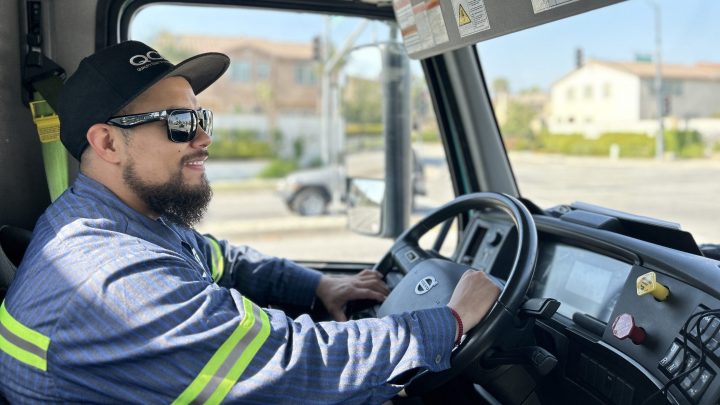
Some trucking companies in California are trying EVs, eyeing a state mandate down the road
Some trucking companies in California are trying EVs, eyeing a state mandate down the road

Edwin Buenrostro moves at a fast pace using metal hooks to move an eight-foot stack of heavy boxes.
To keep food fresh, the truck he drives needs to stay running at every stop along Buenrostro’s 14-hour shift. He does 11 to 16 stops per day to Starbucks locations across the city of Fontana.
Buenrostro is one of the first drivers behind the wheel of an electric Volvo big rig bought by the company he works for: Quality Custom Distribution, or QCD. It’s a division of one of the largest restaurant distribution companies in the U.S.
This electric rig is very different from the diesel trucks he was used to.
“My first thought was how quiet they are,” Buenrostro said. “I was surprised because I’m so used to the vibration of the sound, the noise, the exhaust, like the fumes, the heat coming out of the bottom of the cab.”
He says one of his coworkers suffered severe headaches from fumes getting in the cab. “So that’s toxic for us,” said Buenrostro. “We’re in this truck 14 hours a day.”
Buenrostro said he also feels better driving electric because he’s helping the air quality in the local community.
“That’s when you realize, ‘Hey man, we don’t do something now, our kids’ kids are gonna feel it, you know, 20, 30, 40 years from now.’”
Heavy-duty vehicles spew about 9% of California’s total greenhouse gas emissions and nearly half the pollutants that cause smog, according to the state’s Air Resources Board.
That’s why the Air Resources Board adopted a new mandate in April that requires fleets of 50 or more trucks to be electric or hydrogen-powered by 2042. Port trucks, government fleets and local delivery companies like QCD are required to transition sooner — by 2035. But costs and deadlines concern many companies.
“It’s a lot of capital right now because the scale’s just not there,” said Shane Blanchette, a vice president with QCD.
He said that at about $300,000 each, the trucks cost close to three times as much as a traditional diesel truck. But he said the company was able to buy them at a similar cost to diesel through grants from Southern California Edison and other partners.

QCD already has six electric trucks and Blanchette said another 39 are on the way. “We think this is actually a competitive advantage as we continue to transition,” he said.
Almost all of QCD’s daily routes in southern California are within 120 miles, a range current technology can handle on a single charge.
“It made sense for our business,” Blanchette said. And long-term, he added that the company expects savings on fuel and maintenance costs, and it plans to transition to a solar-powered microgrid charging system.
California’s mandate is likely to have ripple effects across the nation, said UCLA climate policy expert Julia Stein.
“I think we’ll see other states kind of follow California’s lead here,” she said.
That’s what happened with California’s rules on electric cars, which have been adopted by 17 other states.
“Combined, that makes up about 40% of the U.S. market for passenger cars,” Stein said. She expects a similar impact with medium- and heavy-duty trucks.
Back on the road, dialing up the radio in his truck, Buenrostro said he knows he’s at the cutting edge for his industry.
“That’s a benefit now with these trucks, you know, like it’s eco-friendly,” he said. “It’s new. People are scared of it, but it’s the future.”
One immediate benefit in this sweltering California summer? He said the truck’s battery-powered engine is much cooler — not nearly as hot as the old diesel rigs he used to drive.
There’s a lot happening in the world. Through it all, Marketplace is here for you.
You rely on Marketplace to break down the world’s events and tell you how it affects you in a fact-based, approachable way. We rely on your financial support to keep making that possible.
Your donation today powers the independent journalism that you rely on. For just $5/month, you can help sustain Marketplace so we can keep reporting on the things that matter to you.

















